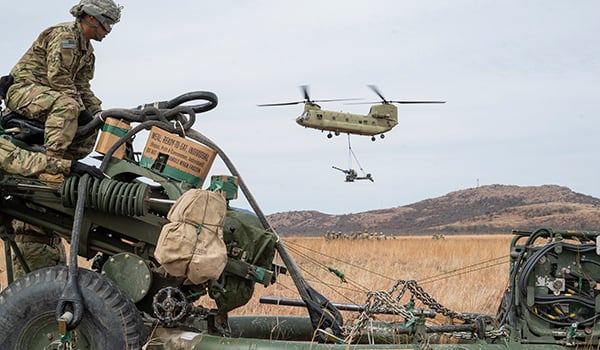
AMCOM Command Sergeant Major Update / By CSM Mike Dove: What is Non Mission Capable Maintenance (NMCM) time? How is it calculated? Why is it important? How can we reduce the NMCM time?

Soldiers from 2nd Battalion, 2nd Field Artillery are getting acquainted with the UH-60 Black Hawk and CH-47 Chinook helicopters during sling load training./ U.S. ARMY PHOTO

NMCM
NMCM is the time an aircraft or component is not mission capable due to maintenance, troubleshooting, repair, or maintenance operational check. NMCM calculates the duration an aircraft is down minus the time waiting for parts. Non-Mission Capable Supply (NMCS) only counts the time waiting for parts to restore the aircraft back to an FMC condition. Once the parts are on hand, the NMCS time stops and NMCM time resumes. The chart at Figure 1 depicts the Department of the Army goals as defined in Army Regulation 700-138 for both manned and unmanned aircraft.
For approximately the past year as a fleet, we average about 20 percent NMCM time on each airframe. As for NMCS, we are well under the standard and have been consistent for the past couple of years at approximately 3 percent across the fleet. Therefore, we are hitting the goal of 75 percent FMC, but it is quite possible to have a higher FMC rate just by reducing the NMCM time a few percentage points.
Leaders on the Flight Line
Some areas where leaders can have a positive impact on reducing NMCM time are in production control meetings, pre-phase maintenance inspection briefings and daily meetings to maintenance and flight crews. A common process often used is Problem, People, Parts, Plan, Time, Tools and Training (P4T3). When I was a PV2 in 1995, P4T3 was not a doctrinal term but it was exactly what our leaders did when we conducted maintenance on the aircraft. Often the maintenance we conducted was for the first time. For example, I did not replace a transmission in Advanced Individual Training (AIT) while learning how to work on the OH-58 but I certainly did it at my first duty station. So where was the training if none of us Privates had ever completed that task previously? Our NCOs conducted the training and supervised us performingthe task. NCOs need to be on the flight line to provide leadership, guidance and training to our young Soldiers out on the flight line or in the hangar. Aviation maintenance is complex and requires trained NCOs and Soldiers to conduct those tasks such as changing out the transmission, periodic inspections, and phase maintenance inspections.
Aviation Maintenance Training Program
All aviation soldiers attend AIT for their initial aviation training on their specific aircraft. As a soldier’s career progresses, they attend the Advanced Leadership Course (ALC) and the Senior Leadership Course (SLC) to learn about the next level of maintenance and maintenance management. These are all great examples of institutional training as described in ADRP 7-0. However, that institutional training only covers the basics and the most frequently conducted tasks. Soldiers and NCOs obtain hands-on experience and learn while maintaining aircraft every day. Historically speaking, we as an enterprise have not done a very good job of recording the routine training our maintainers accomplish every day. The birth of Training Circular (TC) 3-04.71, the Aviation Maintenance Training Program (AMTP) will help us as an enterprise build and keep records of the required training of our maintainers. “The purpose of the AMTP is to enhance readiness and ensure individual maintainers and maintenance teams develop and sustain required skills necessary to successfully complete comprehensive maintenance requirements” (TC 3-04.71, 2018). As an enterprise, we must use the AMTP to record the training that each individual maintainer completed. Recording of maintenance tasks a Soldier performs is an indication of the level of proficiency of our Soldiers. Over the years, Soldiers and NCOs would arrive to a new duty station and be placed in a position based solely on their rank and presumed level of experience. The Platoon Sergeant at Fort Hood had no idea that PV2 Dove had the experience of changing an OH-58 transmission nor any other tasks that he may have done at his first duty station because no one kept records of completed training.
Output
The art and science of leadership is tying it all together. The junior Soldiers and junior NCOs on the flight line only know what they know. They may not know the strategic importance of operational readiness rates or NMCM rates until they reach the rank of staff sergeant or higher. Engaged leaders on the flight line and in the production control meetings have a very strong impact on the outcome of maintenance. Aviation leaders should strive to perfect the art of P4T3 and practice it to ensure the repair operation goes as planned. NCOs should also become familiar with the AMTP and start recording the level of maintenance experience of their Soldiers. Leaders knowing the strength and weakness of their Soldiers is essential in gaining efficiencies on the flight line. Goals can be achieved when all are aware of the goals, the phase timeline schedule, the parts ordering process, and frankly how long it takes to get to the aircraft on the flight line. We as an aviation branch are on the cusp of regularly obtaining 80 percent FMC and engaged leaders at all levels will make the goal of 80 percent a reality.
CSM G. Mike Dove is the command sergeant major of the Aviation and Missile Command at Redstone Arsenal, AL.








